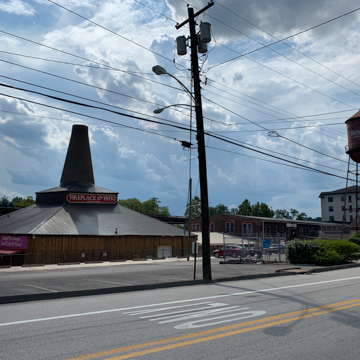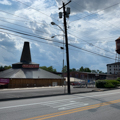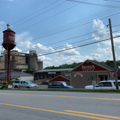Seneca Center
Built in 1896 along the Monongahela River in the Sunnyside neighborhood north of downtown, the Seneca Glass Factory was the most significant glass manufacturer, of more than twenty, in Morgantown’s glass industry for over eighty years and is an important example of a small industrial complex. With raw materials plentiful in the area, glassmaking became vital in the state, with over 9,000 workers employed by World War I in the $4 million a year industry. Within a year of its establishment, over 250 people worked at the Seneca Glass Factory.
Constructed almost entirely of brick, the original one-story complex consisted of a “hot end” and a “cold end.” The hot end contained the blowing and lehr rooms and the reverberatory furnace, which is capped with a hipped roof and its iconic 100-foot conical brick furnace stack. The original stack displayed careful attention to detail in the geometric brick designs created by local masons. These designs were destroyed by a lightning strike and ensuing wind during a storm in 2015, and the reconstructed stack lacks these original designs. The cold end of the factory contained etching and polishing rooms, offices, and the warehouse.
In 1902, a fire ravaged the factory. Taking this as an opportunity for growth rather than a setback, the Seneca Glass Company tasked noted Morgantown architect Elmer F. Jacobs with restoring and expanding the factory. He added a second story and designed a new wing for etching, grinding, and glazing. At some point following this redesign, but certainly before 1911, the 80-foot red steel water tower bearing the words “Seneca Glass Co.” was erected and still serves as a defining feature of the site. Following World War II, the factory expanded again in 1947. The previously separate buildings designed by Jacobs were joined to the main building or removed, uniting the entire complex under a single roof.
The Seneca Glass Company went bankrupt in 1983 as the demand for hand-blown and hand-cut glass disappeared. The complex was bought by a commercial investment company and in 1985 was added to the National Register of Historic Places. In 1998, the owners converted the building into a successful mixed-use assortment of specialty shops, offices, and restaurants, retaining almost all of its original architecture.
References
Boulware, Jenny, et al. “Glass Blowing and Community Building: A History of Morgantown, West Virginia’s Sunnyside Neighborhood, 1890–2013.” West Virginia History: A Journal of Regional Studies 9, no. 1 (2015): 65–88.
Core, Earl Lemley. The Monongalia Story: A Bicentennial History. Vol. 5. Parsons, WV: McClain Print Company, 1974.
Fleming, Dolores A. "Seneca Glass Company Building," Monongalia County, West Virginia. National Register of Historic Places Inventory–Nomination Form, 1985. National Park Service, U.S. Department of the Interior, Washington, D.C.
"Seneca Glass Company Factory," Monongalia County, West Virginia. Historic American Engineering Record, 1973. National Park Service, U.S. Department of the Interior, Washington, D.C. (HAER WVA 31-MORG, 1-).
Wiley, Samuel T. History of Monongalia County, West Virginia; from its Settlement to the Present Time, with Numerous Biographical and Family Sketches. Kingwood, WV: Preston Publishing Company, 1883.
Writing Credits
If SAH Archipedia has been useful to you, please consider supporting it.
SAH Archipedia tells the story of the United States through its buildings, landscapes, and cities. This freely available resource empowers the public with authoritative knowledge that deepens their understanding and appreciation of the built environment. But the Society of Architectural Historians, which created SAH Archipedia with University of Virginia Press, needs your support to maintain the high-caliber research, writing, photography, cartography, editing, design, and programming that make SAH Archipedia a trusted online resource available to all who value the history of place, heritage tourism, and learning.











